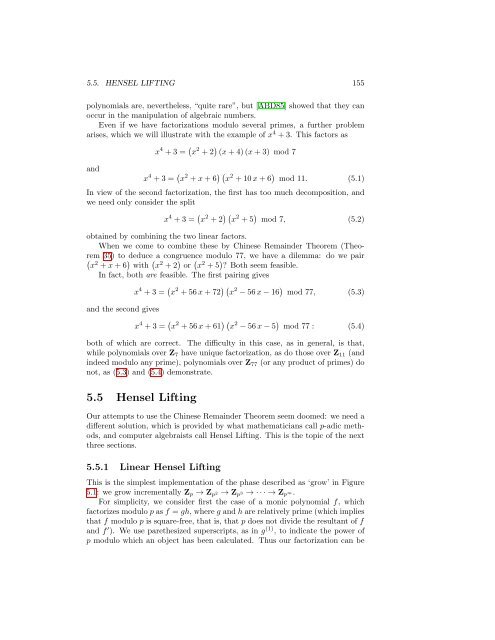Contents - Student subdomain for University of Bath
Contents - Student subdomain for University of Bath
Contents - Student subdomain for University of Bath
Create successful ePaper yourself
Turn your PDF publications into a flip-book with our unique Google optimized e-Paper software.
5.5. HENSEL LIFTING 155<br />
polynomials are, nevertheless, “quite rare”, but [ABD85] showed that they can<br />
occur in the manipulation <strong>of</strong> algebraic numbers.<br />
Even if we have factorizations modulo several primes, a further problem<br />
arises, which we will illustrate with the example <strong>of</strong> x 4 + 3. This factors as<br />
and<br />
x 4 + 3 = ( x 2 + 2 ) (x + 4) (x + 3) mod 7<br />
x 4 + 3 = ( x 2 + x + 6 ) ( x 2 + 10 x + 6 ) mod 11. (5.1)<br />
In view <strong>of</strong> the second factorization, the first has too much decomposition, and<br />
we need only consider the split<br />
x 4 + 3 = ( x 2 + 2 ) ( x 2 + 5 ) mod 7, (5.2)<br />
obtained by combining the two linear factors.<br />
When we come to combine these by Chinese Remainder Theorem (Theorem<br />
35) to deduce a congruence modulo 77, we have a dilemma: do we pair<br />
(<br />
x 2 + x + 6 ) with ( x 2 + 2 ) or ( x 2 + 5 ) ? Both seem feasible.<br />
In fact, both are feasible. The first pairing gives<br />
and the second gives<br />
x 4 + 3 = ( x 2 + 56 x + 72 ) ( x 2 − 56 x − 16 ) mod 77, (5.3)<br />
x 4 + 3 = ( x 2 + 56 x + 61 ) ( x 2 − 56 x − 5 ) mod 77 : (5.4)<br />
both <strong>of</strong> which are correct. The difficulty in this case, as in general, is that,<br />
while polynomials over Z 7 have unique factorization, as do those over Z 11 (and<br />
indeed modulo any prime), polynomials over Z 77 (or any product <strong>of</strong> primes) do<br />
not, as (5.3) and (5.4) demonstrate.<br />
5.5 Hensel Lifting<br />
Our attempts to use the Chinese Remainder Theorem seem doomed: we need a<br />
different solution, which is provided by what mathematicians call p-adic methods,<br />
and computer algebraists call Hensel Lifting. This is the topic <strong>of</strong> the next<br />
three sections.<br />
5.5.1 Linear Hensel Lifting<br />
This is the simplest implementation <strong>of</strong> the phase described as ‘grow’ in Figure<br />
5.1: we grow incrementally Z p → Z p 2 → Z p 3 → · · · → Z p m.<br />
For simplicity, we consider first the case <strong>of</strong> a monic polynomial f, which<br />
factorizes modulo p as f = gh, where g and h are relatively prime (which implies<br />
that f modulo p is square-free, that is, that p does not divide the resultant <strong>of</strong> f<br />
and f ′ ). We use parethesized superscripts, as in g (1) , to indicate the power <strong>of</strong><br />
p modulo which an object has been calculated. Thus our factorization can be












![[Luyben] Process Mod.. - Student subdomain for University of Bath](https://img.yumpu.com/26471077/1/171x260/luyben-process-mod-student-subdomain-for-university-of-bath.jpg?quality=85)



